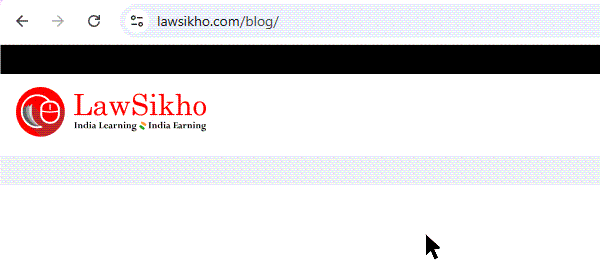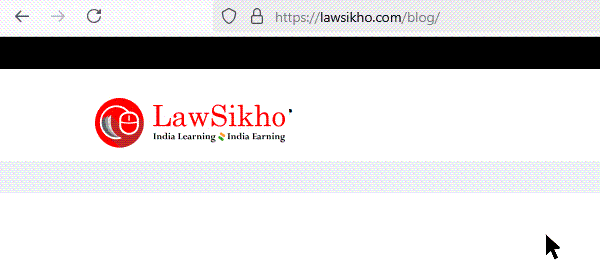Intellectual Property (IP) is no longer a mere legal safeguard; it is a powerful business asset that, when properly managed, can generate significant commercial value. This article offers a comprehensive guide on how creators, entrepreneurs, and business owners can commercialise and monetise their IP assets effectively.
Table of Contents
Learning with AI series
Welcome to the Learning with AI series, where we figure out how to get legal work done faster, smarter, and maybe even a little easier, with the help of AI.
From drafting and research to reviewing contracts or keeping up with the latest case law, we will break down how to actually use AI in your day-to-day legal work; no jargon, no hype, just useful stuff you can start trying right away.
Introduction
Deepak is an independent designer selling handcrafted leather bags through his online store and on marketplaces like Amazon and Flipkart. He is constantly worried that someone will steal his designs and sell them because it happened to him a few years back. When he had initially started his business, someone stole his designs and sold a huge collection at a carnival.
So now, he is so obsessed that he has nightmares about it sometimes. His daily routine includes manually searching any similar designs online. One morning, a loyal customer sends him a message saying that they found a listing on another seller’s page using his product photos, his brand name, and even his exact product descriptions. Worse, the price is half of Deepak’s products. And they had already sold over 1000 products.
He threw his phone in frustration and exclaimed, “Not again!”, but he half expected this, so he was already ready to deal with the situation.
But let us take a step back. How to prevent this in the first place?
Intellectual property infringement on e-commerce platforms is growing rapidly, costing brands, big and small, millions each year. Whether it is counterfeit products using your trademark, unauthorised sellers copying your designs, or rivals stealing your copyrighted product descriptions, the problem has become too large for manual monitoring alone.
This is where artificial intelligence (AI) is going to help. From scanning thousands of listings for copied images to detecting suspicious patterns of seller behaviour, AI tools can help brand owners catch infringements early and respond quickly.
In this article, you will learn how AI is used to identify IP infringement on e-commerce platforms, how to respond when infringements are detected, and what limitations these tools still carry.
Whether you are a small business or an established brand, you will find practical tips to protect your IP in the digital marketplace.
What is IP infringement on e-commerce platforms?
When you list your products on an e-commerce platform, whether it is Amazon, Flipkart, Etsy, or Shopee, you are not only offering your goods to customers, you are also exposing your intellectual property to a large, often uncontrollable marketplace.
But what does IP infringement really mean in this context?
Simply put, IP infringement occurs when someone uses your intellectual property without your permission, violating your legal rights. This could involve your trademark, copyright, patent, or design rights.
Let us briefly understand how each type of IP can be infringed upon in e-commerce:
A trademark protects your brand name, logo, slogan, or any sign that distinguishes your products from others.
On e-commerce platforms, this can happen when another seller uses your registered brand name or logo in their product listings. When counterfeit goods are sold under your brand name, it confuses customers. They can even be paid advertisements on the platform that misuse your trademark to divert customers.
For example, a seller lists “Nike Running Shoes” but actually offers non-Nike products, misleading buyers.
Copyright protects original literary, artistic, musical, and dramatic works, including product descriptions, photographs, videos, and design illustrations.
On e-commerce platforms, this happens when someone copies your product photos or videos, lifts your product descriptions word-for-word, or duplicates your instruction manuals, packaging designs or promotional content are duplicated.
Imagine a competitor copies your high-quality bag photos and uses them to sell similar but inferior bags. Problematic, right?
If you have registered a unique product design, such as the shape, appearance, or pattern, this too can be infringed.
On e-commerce platforms, sellers may sell identical or deceptively similar product designs, violating your design rights.
This is exactly what happened to Deepak. His design of unique handcrafted leather bags, which is a registered design, is being sold by another seller.
Patents protect inventions, new products, or technical processes.
On e-commerce platforms, sellers may offer products that incorporate your patented technology without permission.
Let’s say your company patents a specific water filtration method. Another seller markets a product using the same method without a licence.
Why manual monitoring is no longer enough
At first glance, you may think that keeping an eye on your brand’s listings on Amazon or Flipkart is manageable. After all, how hard can it be to check your own products, right?
But here is the truth: manual monitoring is no longer practical or effective for most businesses. Why? Let us take a look:
- The sheer volume problem
E-commerce platforms host millions of listings from sellers across the world. New products, sellers, and advertisements appear every single day faster than any human team could possibly review.
If you are selling phone accessories and want to check for counterfeit listings, you could easily have to sift through thousands of results daily across global marketplaces. Manually doing this is impossible.
- The speed of infringing listings
Fake or infringing listings do not stay online forever, but they do enough damage before they are removed. Sellers of counterfeit or infringing goods often create short-term listings to avoid detection. By the time you spot the infringement, the product might have already been sold to unsuspecting customers, hurting your brand reputation and sales.
- Global seller base and cross-border infringements
Your brand may be registered in India or the UK, but infringers could be operating from China, Vietnam, the USA, or elsewhere with no easy way for you to detect or act on these listings without automated support. Platforms are borderless. Infringements can happen anywhere, anytime, and manual checks across multiple regions are simply not feasible.
You see this quite often. There are so many small brands from across the globe that sell unique fashion items, but are quickly duplicated and sold by companies like Shein.
- The copycat sophistication problem
Modern infringers are clever. They do not always copy your entire trademark or description; sometimes, they use slight variations or synonyms to dodge keyword filters.
Your registered brand is “UrbanWear”. An infringer uses “UrbnWear” or “Urban Wears”, escaping your manual searches unless you check every variant.
- Human limitations and costs
As I mentioned earlier, constant manual searching is time-consuming. You could hire staff, but if you are not a big business, then hiring staff to check listings 24/7 is expensive. Humans get tired; AI does not.
This is why many businesses, even small ones, are starting to depend on AI-powered tools to watch for infringement quickly, at scale, and across multiple platforms.
How AI tools help in identifying infringement
Artificial Intelligence is not just a buzzword when it comes to intellectual property protection; it is fast becoming an essential part of every brand’s online defence system. But how exactly does AI help you catch infringers on platforms like Amazon, Flipkart, Alibaba, or Etsy?
Let us break this down clearly.
Image recognition for counterfeit goods
AI-powered systems can scan thousands of product photos across listings and detect matches or near matches with your original images or designs. The AI looks for shapes, colours, logos, and patterns in images. Even if the infringer changes the background or resizes the photo, smart AI can spot similarities. This is especially useful for fashion, electronics, jewellery, and design-based products.
So if a seller in another country uses your handbag photo with slight changes. AI recognises the pattern and alerts you to something a manual checker may miss.
Text analysis for copied descriptions or trademarks
AI tools can also read and analyse product descriptions, titles, and even hidden keywords in listings. They detect plagiarised product descriptions, even if small changes are made. AI picks up on misspellings or close variations of your brand name (like “Nikee” instead of “Nike”). They also flag listings using your trademark terms in unauthorised ways.
If your trademark is “GreenTech Solutions” and a seller uses “Green Tek Solutions” to mislead buyers, AI text analysis spots this variation.
Pattern detection of suspicious seller behaviour
AI systems also watch for seller behaviour that signals potential infringement. This includes Sudden spikes in listings of a particular brand name and multiple accounts linked by shared IP addresses or descriptions. It also covers sellers uploading listings for unrelated categories using your keywords.
These patterns are almost impossible for human teams to notice, but AI sees them instantly.
AI tools and platforms already in use
Several technology providers and platforms offer AI-driven brand protection services. Some popular examples include:
Red Points – an AI platform that scans e-commerce, social media, and websites to detect counterfeit listings.
- BrandShield – Provides digital risk protection, monitoring both marketplaces and paid ads.
- Amazon Project Zero – Gives brands access to AI tools to find and remove suspected counterfeit listings without waiting for Amazon’s review.
- Flipkart’s Brand Protection Tool – An Indian marketplace tool that uses algorithms to help registered brands detect IP violations.
- Alibaba’s IP Protection Platform – Uses machine learning to scan and report fake products.
Automation of notices and takedown requests
Some AI systems go beyond detection; they can also automatically generate infringement reports, send takedown notices, or alert platform operators to remove the offending listings.
This saves time and ensures infringers are stopped before they can cause serious harm to your brand.
In short, AI watches where humans cannot, sifting through millions of listings, detecting small but crucial clues, and warning you before damage is done.
How to respond to infringement after AI detection
So your AI tool has detected a suspicious listing. What is next?
Detection is only half the battle. You also need to act quickly and effectively to prevent damage to your brand and reputation.
Let us walk through the key steps to respond after AI identifies potential IP infringement.
Human verification is essential
Even the smartest AI can make mistakes. Some listings flagged by AI may not actually infringe your rights. Before taking action, you (or your legal team) must manually check is the listing truly using your trademark, design, or copyright without permission?, could the use fall under exceptions (such as fair use or authorised resale)?, and is the listing based in a region where your IP is not protected?
This human verification step helps avoid sending wrongful claims, which could backfire legally or damage your brand image.
Use platform-specific IP reporting tools
Most major e-commerce platforms offer in-built mechanisms for IP owners to report violations. Once you confirm infringement, these are your quickest enforcement options.
Send cease and desist notices
If the infringer operates outside the platform, for example, running their own online store, you may need to send a formal cease and desist notice. A legal notice warns the infringer to stop the unauthorised use of your IP immediately. If ignored, you can proceed to court action, depending on the seriousness of the infringement.
How do you draft one? Check this. And how do you send one? Check this.
Consider legal action if necessary
If platform-based complaints or cease and desist letters do not work, you may have to take legal action.
This means Civil suits for injunctions and damages, and criminal complaints for counterfeiting under laws like the Indian Trade Marks Act, 1999, or the Copyright Act, 1957. Customs records are used to stop counterfeit goods at the border.
In India, for example, filing a suit under Section 135 of the Trade Marks Act can help you obtain injunctions and claim damages.
Keep records for future protection
Maintain detailed records of all AI detection reports, screenshots of infringing listings, correspondence with infringers or platforms and takedown confirmations
These can be valuable if you face repeat offenders or need to prove infringement in court later.
Involve your IP lawyer early
For serious or repeated infringement, involving a specialised IP lawyer early can save time, reduce risk, and improve outcomes. They can draft cease and desist letters, file platform complaints properly and advise on court action or settlement options
Essentially, AI detects. You verify. Platforms act. Lawyers follow up if needed.
This combined approach ensures your IP remains safe and enforceable in the fast-moving world of e-commerce.
Case studies: Indian brands and platforms using technology to fight infringement
- Beverly Hills Polo Club vs Amazon India
In a landmark February 2025 ruling, the Delhi High Court determined that Amazon India sold counterfeit Beverly Hills Polo Club (BHPC) garments through third-party sellers using identical branding. The Court awarded ₹292.7 crore for lost royalties and ₹43.32 crore for brand repair costs, totalling over ₹339 crore, and imposed a permanent injunction against Amazon India. This sets a major precedent: platforms can now be held liable if they fail to act promptly on IP complaints.
- Amazon’s Project Zero and Brand Registry in India
Amazon’s Project Zero allows brand-registered businesses to self-remove counterfeit listings. Brands upload their trademarks, and the AI-driven tool scans global listings in real time. According to Amazon, brands using Brand Registry and Project Zero have blocked or removed 99 per cent of infringing listings before any manual report was required. Indian firms enrolled in the Brand Registry can likewise leverage these tools to detect and take down counterfeit listings swiftly.
- Reactive removal by Amazon
In 2022, Amazon globally removed six million counterfeit products, 5,000 fake brands, and prevented over 800,000 illegitimate seller sign-ups. This demonstrates the scale and effectiveness of AI and automated platforms on global marketplaces.
Limitations and challenges of AI-driven monitoring
While AI is a powerful tool in the fight against IP infringement on e-commerce platforms, it is not a perfect solution. Businesses, especially small and medium enterprises, must be aware of certain limitations and challenges before relying solely on AI systems.
False positives and false negatives
AI tools are only as good as their training data and algorithms.
- False positives: Sometimes, AI may flag listings as infringing when they are not, such as authorised resellers or generic products that resemble your goods but do not actually infringe. Acting on these without verification could lead to wrongful claims and potential legal backlash.
- False negatives: AI may also miss clever or disguised infringement, such as slightly modified product designs or listings in lesser-known regional platforms that humans might catch.
Lack of legal judgment
AI can detect similarities in text, images, or patterns, but it cannot decide whether the use falls under permitted exceptions (such as comparative advertising or legitimate reselling). They can also not decide whether the infringement amounts to a legal violation under IP laws in different jurisdictions.
Human legal review remains essential for final decisions.
Cost and accessibility for small businesses
While large brands may afford advanced AI systems or third-party services (like Red Points or BrandShield), smaller businesses face budget constraints. Many small brands depend on the free or basic tools provided by platforms (such as Amazon Brand Registry), which may offer limited coverage. Full-scale AI monitoring solutions can be costly, especially for global protection.
Platform dependence
AI-driven monitoring is often tied to major platforms (like Amazon or Alibaba). However, infringements may occur on smaller, regional marketplaces, social media, or standalone websites where AI coverage is limited.
Businesses need to combine AI tools with manual searches or third-party monitoring for a truly comprehensive watch.
Data privacy and security concerns
Some businesses may hesitate to feed sensitive IP data (like product images, blueprints, or designs) into third-party AI platforms, fearing data breaches or leaks, misuse of proprietary information, and issues with cross-border data storage (especially under laws like GDPR)
Careful selection of trustworthy, certified AI service providers is essential.
AI does not enforce humans, and platforms do
Remember: AI can detect and alert, but it cannot remove listings or file legal actions itself. Human intervention is still required to verify findings, initiate takedowns, send legal notices, and pursue court remedies.
In short, AI is an aid, not a replacement for legal strategy.
Despite these challenges, AI remains an invaluable part of modern IP protection, especially when used in combination with human review, legal expertise, and platform tools.
Role of government and industry bodies in Indian IP protection
India’s IP laws, including the Trade Marks Act (1999), Copyright Act (1957), Designs Act (2000), and IT Intermediary Rules (2021) oblige platforms to respond to IP complaints when notified. Enforcement is overseen by the CGPDTM (Indian Patent Office).
Government-funded schemes
The Scheme for Facilitating Startups Intellectual Property Protection (SIPP), administered via WIPO‑linked TISCs, provides subsidised IP filing and support for startups and innovators. SIPP was extended in 2023 through at least 2026.
National IP awareness initiatives
Under the National IPR Policy (2016), the National IPR Awareness Mission (NIPAM) has conducted over 9,000 training programmes benefiting more than two million individuals, aimed especially at MSMEs and students.
IP facilitation centres and industry support
IP facilitation centres (IPFCs), often embedded within MSME clusters, provide guidance on IP registration, usage, and leveraging tools, including AI for protection DPIIT continues to fund and modernise CGPDTM offices across the country to streamline filings and awareness
Tips for businesses to integrate AI in their IP protection strategy
AI tools can be incredibly effective, but only if used wisely as part of a larger intellectual property protection plan. Here are some practical, actionable tips for businesses, whether you are a small start-up or a large brand.
Choose AI tools that suit your business size and needs
Small businesses may start with free or platform-provided tools like Amazon Brand Registry or Flipkart’s Brand Protection Tool.
Mid-sized or global brands may consider affordable third-party solutions like Red Points, BrandShield, or Yellow Brand Protection, which offer more features across multiple marketplaces.
Before investing in expensive software, assess your risk level (counterfeit exposure, geographic spread, product type).
Use AI as a first filter, but never skip human review
We have been over this already, but I stress again, always have a team member or IP lawyer review AI-flagged listings before acting. False positives can harm relations with genuine resellers or customers, and avoid automatic takedown without checks.
Combine AI with manual market research
Even the best AI tools may miss local infringements, especially on regional platforms, WhatsApp groups, or small online stores. Regular manual searches or hiring market investigators can catch what AI cannot.
Regularly update your brand assets fed into AI tools
Upload your latest product images, logos, packaging designs, and trademarks into your AI system. Update the AI system whenever you launch new designs or products so that fresh infringements can be spotted.
Train your team to use AI alerts effectively
Ensure your staff or legal team knows how to interpret AI reports, investigate alerts, and act on them properly. Develop a clear internal process:
AI detects → Team verifies → Platform action/legal notice → Follow-up.
Budget for AI as part of your IP protection costs
IP protection is no longer just about court cases or registrations. AI monitoring is now a core cost of brand defence, especially for e-commerce sellers. Factor this into your annual budget and weigh the cost against the potential losses from unchecked infringement.
Conclusion: The future of IP enforcement on e-commerce platforms
In the fast-evolving world of online commerce, protecting your intellectual property is no longer optional; it is essential. As counterfeiters, infringers, and copycats become more sophisticated, businesses must equip themselves with equally advanced tools to defend their brands.
Artificial intelligence has emerged as a powerful ally in this fight. From scanning thousands of listings for unauthorised uses of your trademarks, to detecting copied product descriptions or counterfeit images, AI makes it possible to guard your IP rights across vast digital marketplaces, something manual monitoring could never achieve.
However, AI is not magic. It must be used carefully with human verification, legal judgment, and platform-specific actions to avoid mistakes and maximise its effectiveness. Small businesses need not feel left behind; affordable or even free AI tools are available on most major platforms, making brand protection accessible to all.
Looking ahead, AI-driven IP protection will only grow in importance. As global e-commerce expands and infringers get smarter, brands that fail to adopt AI monitoring risk losing market share, reputation, and revenue. Those who integrate AI smartly alongside legal expertise will enjoy stronger, more secure positions in the marketplace.
In short, AI will not replace your IP lawyer or legal strategy, but it will make them sharper, faster, and far more effective.
Frequently asked questions (FAQs)
- Can small businesses afford AI-powered IP monitoring tools?
Yes. Most major e-commerce platforms like Amazon and Flipkart offer free or low-cost brand protection tools that use AI. More advanced, cross-platform services like Red Points or BrandShield may have costs, but entry-level packages are often available for small brands.
- Are AI detection results accepted as evidence in court?
AI-generated reports can serve as supporting evidence (such as screenshots, detection logs), but courts will usually require human verification and legal confirmation of infringement. AI findings alone may not be sufficient to prove infringement without human review and documentation.
- What should I do if an AI tool wrongly flags a genuine reseller or partner?
Always verify AI alerts before acting. If a genuine reseller is wrongly flagged. Do not send a takedown or legal notice immediately; contact the seller or investigate further and consider updating your AI filters to reduce future false positives.
- Is AI monitoring enough to protect my IP?
No. While AI is a strong first line of defence, it must be part of a broader IP protection plan, which includes human verification, legal action where necessary, platform-specific takedown procedures and manual market checks for smaller or local platforms
- Are there any Indian AI tools or services for IP protection?
While most AI IP monitoring tools are global, Indian businesses can use:
- Flipkart’s Brand Protection Tool
- Amazon India’s Brand Registry
- Local IP law firms that offer custom AI monitoring packages in partnership with global tools






 Allow notifications
Allow notifications
